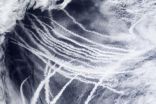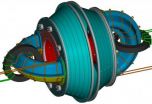(Press-News.org) Space debris came into focus last week at the International Astronautical Congress in Naples, Italy. Envisat, ESA's largest Earth observation satellite, ended its mission last spring and was a subject of major interest in the Space Debris and Legal session.
Envisat was planned and designed in 1987, a time when space debris was not considered to be a serious problem and before the existence of mitigation guidelines, established by the UN in 2007 and adopted the next year by ESA for all of its projects.
Only later, during the post-launch operational phase, did Envisat's orbit of about 780 km become a risky debris environment, particularly following the Chinese antisatellite missile test in 2007 and the collision between the Iridium and the Cosmos satellites in 2009.
Lowering Envisat to an orbit that would allow reentry within 25 years, however, was never an option because of its design and limited amount of fuel.
Even if controllers had lowered the satellite immediately after launch in 2002, there would not have been enough fuel to bring it down low enough – to around 600 km – where it could reenter within 25 years.
In 2010, part of the remaining fuel was used to lower the satellite slightly into a less crowded orbit at 768 km, while keeping enough reserve to provide collision avoidance for several years.
The lower orbit also ensured continuity of crucial Earth-observation data until the next generation of satellites – the Sentinels – are fully operational in 2013.
In April 2012, however, contact with Envisat was suddenly lost, preventing ESA from controlling the spacecraft and disrupting data provision to the international Earth observation user community.
ESA is strongly committed to reducing space debris. Today, the deorbiting of missions is taken into consideration during the development of future satellites, and during the operations of current satellites when technically feasible.
Indeed, ESA decided to terminate operations of the 16-year-old ERS-2 satellite in 2011 because there was still enough fuel to lower its orbit to about 570 km, allowing it to reenter well within 25 years.
During the last years of Envisat, ESA began to investigate new technology to deorbit space debris in a controlled fashion.
The problem of debris in low orbits is of paramount importance. ESA space debris represents about 0.5% of the more than 16 000 objects catalogued by the US surveillance network.
ESA is working together with other agencies to reinforce international cooperation in monitoring space debris and to study mitigation and remediation measures that will ensure the future of space endeavours.
During its extended operational lifetime, Envisat provided crucial Earth observation data not only to scientists, but also to many operational services, such as monitoring floods and oil spills.
Its data supported civil protection authorities in managing natural and man-made disasters.
An estimated 2500 scientific publications so far have been based on the data provided by the satellite during its ten-year life.
### END
Focus on space debris: Envisat
2012-10-12
ELSE PRESS RELEASES FROM THIS DATE:
Discovery reveals important clues to cancer metastasis
2012-10-12
BOSTON – In recent years investigators have discovered that breast tumors are influenced by more than just the cancer cells within them. A variety of noncancerous cells, which in many cases constitute the majority of the tumor mass, form what is known as the "tumor microenvironment." This sea of noncancerous cells and the products they deposit appear to play key roles in tumor pathogenesis.
Among the key accomplices in the tumor microenvironment are mesenchymal stem cells (MSCs), a group of adult progenitor cells which have been shown to help breast cancers maneuver and ...
Nerve and muscle activity vary across menstrual cycle
2012-10-12
WESTMINSTER, CO (October 10, 2012)—Numerous studies have shown that female athletes are more likely to get knee injuries, especially anterior cruciate ligament (ACL) tears and chronic pain, than their male counterparts. While previous research has focused on biomechanical differences as the main source of these problems, a new study suggests another distinction that could play a role: changes across the menstrual cycle in nerves that control muscle activity. The finding may eventually lead to new ways to prevent knee problems in female athletes.
Matthew Tenan, Yi-Ling ...
UT study: Natural playgrounds more beneficial to children, inspire more play
2012-10-12
KNOXVILLE—Children who play on playgrounds that incorporate natural elements like logs and flowers tend to be more active than those who play on traditional playgrounds with metal and brightly colored equipment, according to a recent study from the University of Tennessee, Knoxville.
They also appear to use their imagination more, according to the report.
The study, which examined changes in physical activity levels and patterns in young children exposed to both traditional and natural playgrounds, is among the first of its kind in the United States, according to Dawn ...
Terrorism risk greatest for subway/rail commuters, says MIT paper at INFORMS conference
2012-10-12
Despite homeland security improvements since September 11, 2001, subway and rail commuters face higher risks of falling victim to terrorists and mass violence than frequent flyers or those engaged in virtually any other activity. And while successful criminal and terrorist acts against aviation have fallen sharply, those against subways and commuter trains have surged. These are among the findings of a new study by Arnold Barnett, George Eastman Professor of Management Science at MIT's Sloan School of Management, who will deliver a presentation titled "Has Terror Gone to ...
Antibiotic resistance a growing concern with urinary tract infection
2012-10-12
CORVALLIS, Ore. – As a result of concerns about antibiotic resistance, doctors in the United States are increasingly prescribing newer, more costly and more powerful antibiotics to treat urinary tract infections, one of the most common illnesses in women.
New research at Oregon State University suggests that the more powerful medications are used more frequently than necessary, and they recommend that doctors and patients discuss the issues involved with antibiotic therapy – and only use the stronger drugs if really neeeded.
Urinary tract infections are some of the ...
Earth sunblock only needed if planet warms easily
2012-10-12
RICHLAND, Wash. -- An increasing number of scientists are studying ways to temporarily reduce the amount of sunlight reaching the earth to potentially stave off some of the worst effects of climate change. Because these sunlight reduction methods would only temporarily reduce temperatures, do nothing for the health of the oceans and affect different regions unevenly, researchers do not see it as a permanent fix. Most theoretical studies have examined this strategy by itself, in the absence of looking at simultaneous attempts to reduce emissions.
Now, a new computer analysis ...
Engineered flies spill secret of seizures
2012-10-12
VIDEO:
Fruit flies with a genetic tendency toward fever-induced seizures (top) are the first to stop moving freely and are swept aside by a gentle air current as the temperature rises....
Click here for more information.
PROVIDENCE, R.I. [Brown University] — In a newly reported set of experiments that show the value of a particularly precise but difficult genetic engineering technique, researchers at Brown University and the University of California–Irvine have created a Drosophila ...
Researchers work across fields to uncover information about hadrosaur teeth
2012-10-12
GAINESVILLE, Fla. — An unusual collaboration between researchers in two disparate fields resulted in a new discovery about the teeth of 65-million-year-old dinosaurs.
With the help of University of Florida mechanical engineering professor W. Gregory Sawyer and UF postdoctoral researcher Brandon Krick, Florida State University paleobiologist Gregory Erickson determined the teeth of hadrosaurs — an herbivore from the late Cretaceous period — had six tissues in their teeth instead of two. The results were published in the journal Science Oct. 5.
"When something has been ...
Notre Dame researcher helps make Sudoku puzzles less puzzling
2012-10-12
For anyone who has ever struggled while attempting to solve a Sudoku puzzle, University of Notre Dame researcher Zoltan Toroczkai and Notre Dame postdoctoral researcher Maria Ercsey-Ravaz are riding to the rescue. They can not only explain why some Sudoku puzzles are harder than others, they have also developed a mathematical algorithm that solves Sudoku puzzles very quickly, without any guessing or backtracking.
Toroczkai and Ravaz of Romania's Babes-Boylai University began studying Sudoku as part of their research into the theory of optimization and computational complexity. ...
Mug handles could help hot plasma give lower-cost, controllable fusion energy
2012-10-12
Researchers around the world are working on an efficient, reliable way to contain the plasma used in fusion reactors, potentially bringing down the cost of this promising but technically elusive energy source. A new finding from the University of Washington could help contain and stabilize the plasma using as little as 1 percent of the energy required by current methods.
"All of a sudden the current energy goes from being almost too much to almost negligible," said lead author Thomas Jarboe, a UW professor of aeronautics and astronautics. He presents the findings this ...


